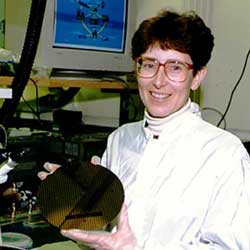Alice White
 Alice White proves that you can go home again. White grew up in Berkeley Heights, New Jersey, the daughter of two physicists. Her father worked at Bell Laboratories, a world-reknown physics research laboratory then part of the old Bell System monopoly. Now, White lives in the same town and works as a physicist for Bell Labs. “I'm very proud of the career I've built in physics,” White said.
Alice White proves that you can go home again. White grew up in Berkeley Heights, New Jersey, the daughter of two physicists. Her father worked at Bell Laboratories, a world-reknown physics research laboratory then part of the old Bell System monopoly. Now, White lives in the same town and works as a physicist for Bell Labs. “I'm very proud of the career I've built in physics,” White said.
After spending her childhood in Berkeley Heights, White went to Middlebury College, a small liberal arts school in Vermont. The summers after her sophomore, junior and senior years of college, she participated in the Bell Laboratories Summer Research Program--a ten-week research internship for women and minorities in the physical and computer sciences. After graduating from Middlebury with a physics degree, she was awarded a fellowship from the Bell Laboratories Graduate Research Program for Women (GRPW), and entered Harvard University to pursue a PhD in Physics. Her mentor for the fellowship was Doug Osheroff, who went on to win the Nobel Prize for Physics in 1996. “When I was feeling a little bit discouraged in graduate school, I could call my mentor at Bell Labs for a different perspective,” White said. “It was great.”
White returned to Bell Labs for yearly visits during graduate school, then took a postdoctoral position, a short-term research job, at Bell Labs after she graduated. After two years as a “postdoc,” she was promoted to the permanent technical staff. In this position, she studied how to add other materials to silicon wafers and discovered a new technique she called “mesotaxy.”
Many electronic components consist of layers of metal ions, a few hundred atoms thick, buried inside wafers of silicon. Before White's invention, many people had tried to grow single crystal silicon on top of metal layers, but no one could figure out how. Mesotaxy avoids those difficulties by making the components the other way around. “We didn't grow the silicon on top,” White said, “we actually grew the metal inside.” Mesotaxy makes it much easier to add metal into electronics - for example, if you want to connect a metal plate to the bottom of a silicon component, mesotaxy allows you to grow a connection inside the silicon, leaving the silicon untouched.
The research that led to mesotaxy involved a team of experts specializing in many different areas of physics: high-energy physicists, semiconductor physicists, and microscopists. “I had a whole bunch of collaborators, which made it a lot of fun,” White said. After developing mesotaxy, White moved on to working with integrated photonic circuits, devices that work by manipulating light rather than electrons.
Unlike physicists in universities, who usually stay in one specialized research area, physicists in corporate research labs generally take on projects in many different areas of physics. “It gives you a lot of flexibility,” White said. “I've had a chance to learn many things.” White also works as a manager for her team. “I go to a lot of meetings,” she said. “I need to make sure that the people under me have information they need to pick their projects.” By getting information from the Labs' management to her team, White helps them set priorities for their research. White enjoys the impact that her research at Bell Labs has on Lucent's business. “If you make an invention or improvement, you have the possibility of a huge impact,” White said. “This is technology that is going to affect the whole world.”
White is married to another Bell Labs physicist and still lives in Berkeley Heights. They have two daughters who attend the same elementary school that she did. She enjoys skiing and bicycling, and gives talks and physics demonstrations to children at elementary schools in the area. She is also a mentor for the same Bell Labs GRPW fellowship program that she participated in as a graduate student. “You wish that in 25 years, the need for these programs would have vanished,” she said - today, women are still underrepresented in physics, especially at universities. “But since I had firsthand experience, and really benefited from [the fellowship] myself, it's something that I'm happy to give back.”











